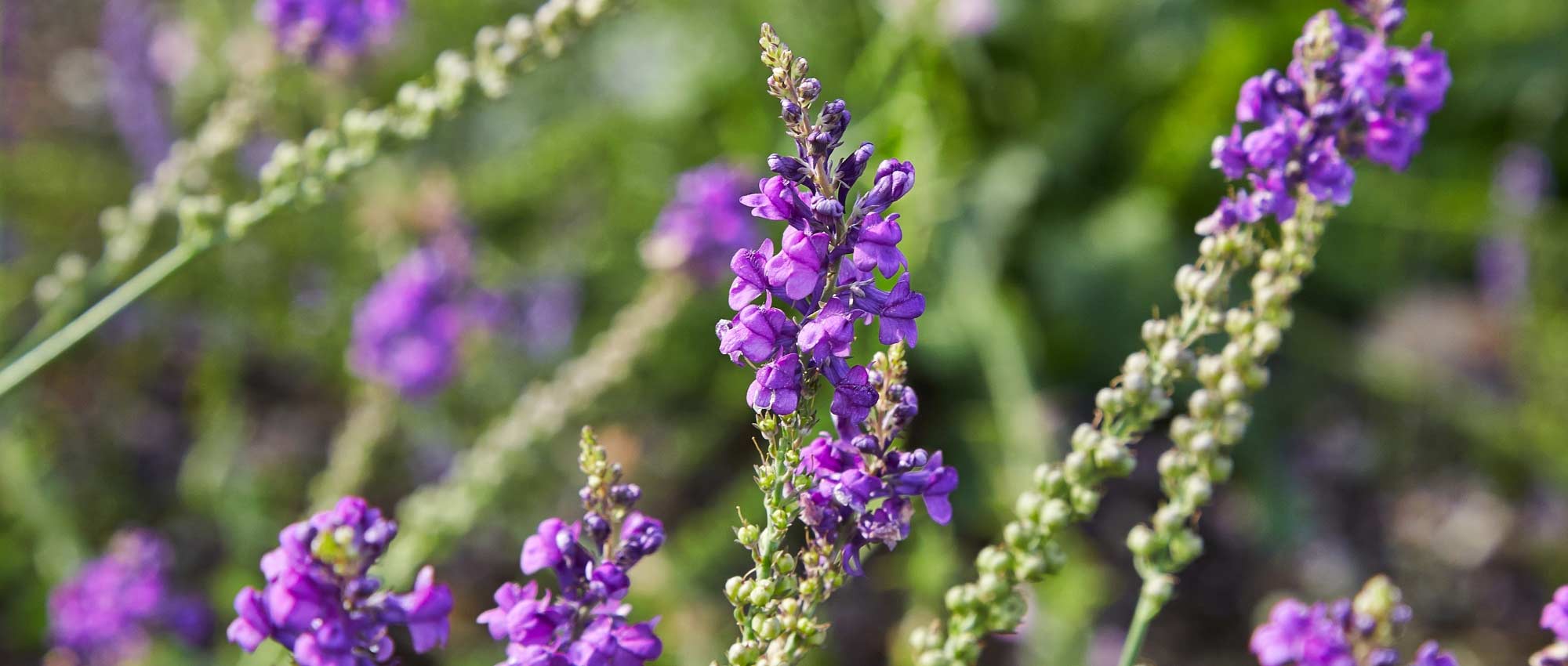
Toadflax, Linaria: sowing, planting, cultivation and care
Contents
Toadflax in a nutshell
- Toadflax offers charming small flowers in summer, gathered in light, graceful clusters
- These declinate into a range of colours, often soft: mauve-violet, yellow, orange, pink, white…
- It bears small, delicate, slender leaves, often bluish
- Adapted to well-drained, sandy soils, perfect in rockeries and requiring little maintenance.
A word from our Expert
The toadflaxes are delightful plants that charm with lightness and delicacy of their small flowers, gathered in very airy clusters. They flower in summer, producing flowers that come in a palette of soft colours: mauve, yellow, pink, orange, white… They resemble miniature snapdragons, but are finer and more delicate. Toadflaxes are generally perennials with a short lifespan, but reseed generously if conditions suit them. They can also be annuals, like Moroccan toadflax, Linaria maroccana.
Certain species and varieties stand out for their remarkable flowering. Among them, Linaria purpurea offers an elegant deep-purple flowering, made up of long clusters of flowers. Variety Linaria ‘Canon J. Went’ is sublime for its soft pink flowering, very romantic. The variety ‘Peachy’ also bears flowers in very soft hues, in a subtle blend of yellow, orange and pale pink. Finally, common toadflax, Linaria vulgaris, is a species found wild in France and offers a lovely yellow flowering.
Toadflaxes prefer well-drained, rather sandy or stony soils, and can easily be planted in a rockery. They require little maintenance, are hardy and not very susceptible to disease. Also, when they take to a spot, they readily reseed in the garden!
Botany
Botanical data
- Latin name Linaria sp.
- Family Plantaginaceae
- Common name Toadflax
- Flowering between June and September, depending on variety,
- Height between 10 cm and 1.20 m
- Exposure full sun, possibly partial shade
- Soil type well-drained, rather sandy
- Hardiness between -15 and -25 °C
Toadflaxes comprise around a hundred species of herbaceous plants native to temperate regions of the Northern Hemisphere (Europe, Asia and North Africa). Greatest diversity occurs around the Mediterranean Basin. Toadflaxes can be perennials or annuals, such as Linaria maroccana. Even when perennial, they generally have a short lifespan… but they make up for it by self-seeding!
In France, 17 species occur in the wild. Most common are Linaria vulgaris, L. repens and L. supina, present across most of the country. Others have a more restricted distribution: Linaria alpina grows in mountain regions up to 3,500 m altitude, while Linaria arenaria (sand toadflax) is found on Atlantic coastal dunes. In general, toadflaxes prefer open, sunny habitats. They are mainly found in wastelands, uncultivated places, short grass meadows, scree…
Toadflaxes belong to family Plantaginaceae, but were formerly placed in Scrophulariaceae. Plantaginaceae include plantain but also foxgloves (Digitalis), Penstemon, veronicas, Bacopa, snapdragons… These are herbaceous plants that form basal rosettes of leaves, have flowers with fused petals, generally four stamens, and produce capsules.
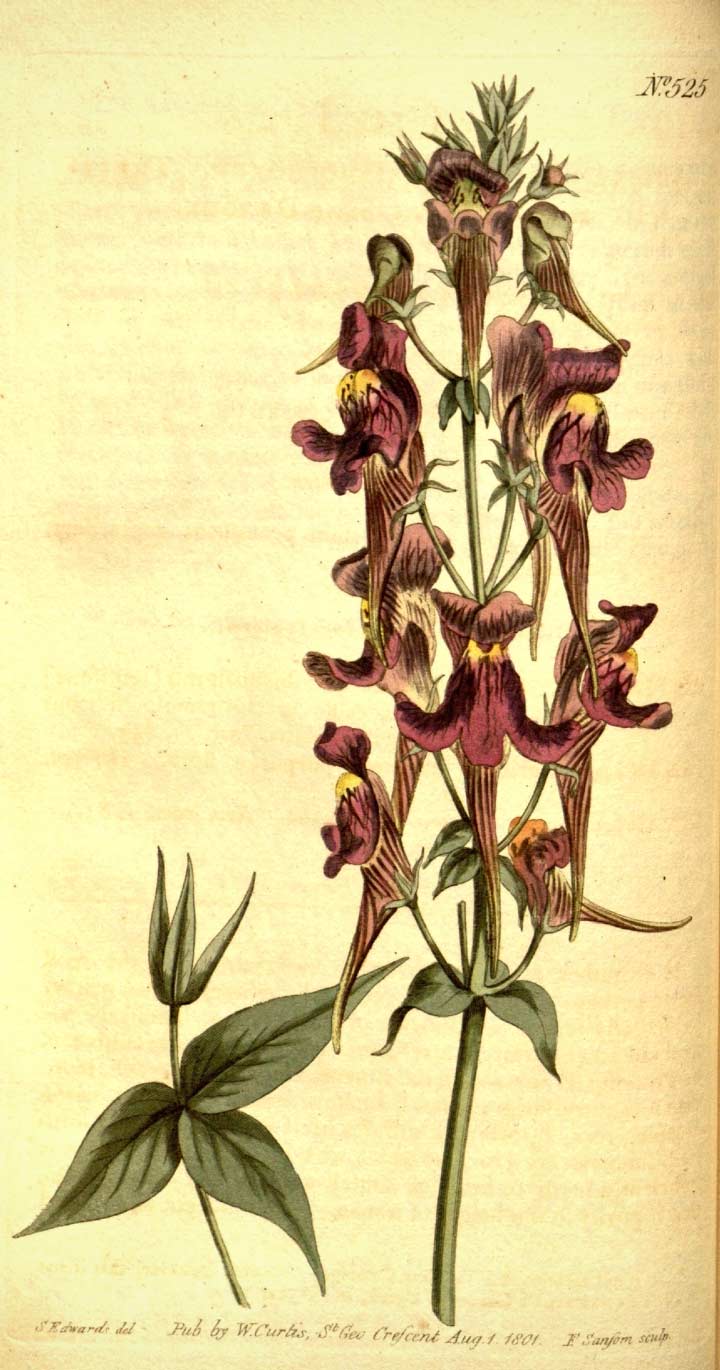
Linaria triornithophora: botanical illustration
Toadflaxes are very close to Cymbalaria; this is obvious when observing small flowers of ivy-leaved toadflax (Cymbalaria muralis), which strongly resemble Linaria flowers. These plants are also close to snapdragons (Antirrhinum). Flowers of these three genera share a similar shape.
Linaria was named because its leaves resemble those of flax. In English, Linaria are called Toadflax; Linaria vulgaris itself is called Butter-and-Eggs because of its yellow colour. Latin specific epithets also provide clues: Linaria vulgaris means common toadflax; Linaria purpurea means purple toadflax; Linaria repens: creeping toadflax; Linaria alpina: alpine toadflax, etc.
Wild species are interesting in their own right, but a few horticultural varieties have been selected for ornamental qualities. Most commonly cultivated are Linaria purpurea, L. vulgaris, L. alpina and L. maroccana.
Some toadflaxes are very small, such as Linaria alpina, which does not exceed 10 cm in height. Others, like Linaria dalmatica, reach 1 m. Overall, however, toadflaxes remain modest in size, with a thin, delicate appearance.
Toadflaxes have thin, flexible stems. Often stems are erect. However, some species are creeping, like Linaria alpina, which stays at ground level and very low.
Depending on species, flowering occurs between June and October. Flowering of Linaria purpurea and Linaria vulgaris lasts a long time, throughout summer. Toadflax flowers are small and gathered in clusters, usually at the tips of erect stems. In Linaria alpina, unlike other species, flowers appear more or less at ground level and remain very low.
Clusters can be long and slender, very elegant, as in Linaria purpurea. Other times they are shorter, as in Linaria anticaria, with flowers appearing more scattered among the foliage. When plants bear numerous erect stems covered in small flowers, toadflaxes have an airy, extremely light appearance.
Their flowering is appreciated for its delicate look and unusual shape. Toadflax flowers have bilateral symmetry, they are zygomorphic. They have an original shape and resemble snapdragon flowers (Antirrhinum majus), only much smaller. Like snapdragons, they evoke a mouth-like form. Linaria flowers measure between 1 and 5 cm long. Largest are found in Linaria triornithophora, while some species have minute flowers, such as Linaria micrantha.
Flowers consist of five fused petals forming two lips. Upper lip comprises two lobes (two fused petals) and lower lip three lobes. Upper lip is upright, lower lip forms at its base a swelling, often of a more pronounced colour, which serves to indicate the flower entrance to the insect. If corolla is opened, four stamens can be seen (two long and two short) carrying the pollen, and a style. At the back of the flower, petals extend into a spur, which contains nectar. It can be short, as in Linaria repens, or much longer, as in Linaria triornithophora. It is usually directed towards the ground and slightly curved at the tip. It adds originality to the flowering!

Flowering of toadflaxes: Linaria pelisseriana (photo Donald Hobern) / Linaria vulgaris (photo Frank Vincentz) / A bumblebee pollinating a Linaria vulgaris flower (photo Ivar Leidus)
Insects must slip between the two lips formed by the petals, then insert their proboscis into the spur to reach the nectar. Nectar is therefore not accessible to all insects… they must be robust enough to open the flower, get inside and reach the nectar. These flowers are therefore pollinated mainly by bumblebees.
Toadflaxes display fairly soft hues in a superb palette of colours: pale yellow, purple, pink, orange, white… The throat, the swollen part formed by the lower lip, is often a stronger shade or a different colour from the rest of the petals, as in Linaria alpina, which has purple flowers contrasted by an orange throat. In Linaria anticaria, flowers bear fine dark-purple veins standing out on pinkish-white petals, and those of Linaria repens are veined with violet. Variety ‘Canon J. Went’ produces long, fine clusters in pinkish-white tones, giving a particularly romantic, delicate look. The variety Linaria purpurea ‘Alba’ stands out for the elegance of its pure white flowering, very graceful. Yellow-flowered species, such as Linaria dalmatica, are valuable for bringing dynamism and brightness to a border.
Toadflaxes have very attractive foliage. Their leaves are small and numerous, spaced regularly along stems. They generally measure between 1 and 6 cm long and are very narrow, linear. They closely resemble flax leaves in their fineness; this is what gave the plant its name. Reduced leaf surface limits water evaporation, making the plant more drought-resistant. Linaria dalmatica, however, differs by its rather broad leaves compared with other species. Linaria leaves are sessile, the lamina being directly attached to the stem without a petiole.
Leaves can be green, but often tend towards grey-blue. Their hue harmonises well with the flowers.
In general, lower leaves on stems are whorled (more than two leaves inserted at the same point) or opposite, while upper leaves are alternate (placed one after another).

Foliage of Linaria vulgaris (photo Frank Vincentz), Linaria purpurea (photo Franz Xaver), and Linaria dalmatica
Some species, like Linaria vulgaris, possess rootstock, enabling them to spread.
After flowering, toadflax produces subglobose capsules with two chambers. When ripe, they open to release many small seeds. Some species have winged seeds, allowing wind dispersal.
You can collect seeds to sow. But if growing conditions suit (well-drained, light soil), toadflax will often self-seed in your garden. It does not become invasive, though. If you want to prevent spontaneous seedlings, simply remove faded flower stems.

Capsules of Linaria vulgaris / Capsules and seeds of Linaria genistifolia (photo Stefan Lefnaer)
Read also
Care of perennial plantsMain toadflax varieties
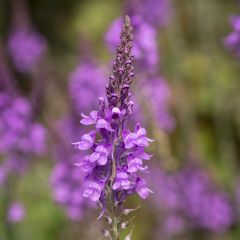
Linaria purpurea
- Flowering time July to October
- Height at maturity 80 cm

Linaria purpurea Canon J. Went
- Flowering time July to November
- Height at maturity 80 cm
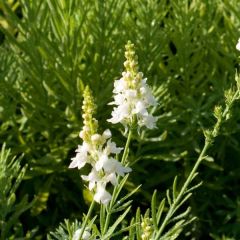
Linaria purpurea Alba
- Flowering time July to October
- Height at maturity 80 cm
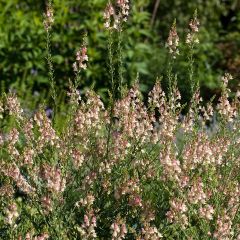
Linaria purpurea Peachy
- Flowering time July to November
- Height at maturity 80 cm
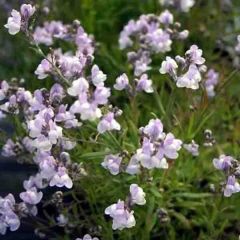
Linaria anticaria Antique Silver
- Flowering time June to September
- Height at maturity 15 cm
Discover other Linaria - Toadflax
View all →Available in 0 sizes
Available in 1 sizes
Available in 1 sizes
Available in 1 sizes
Available in 1 sizes
Available in 1 sizes
Available in 1 sizes
Available in 1 sizes
Available in 1 sizes
Available in 1 sizes
Planting
Where to plant?
Plant Linaria preferably in full sun: in the wild, it mainly grows in open mediums, where it can benefit from good light. However, it can also be placed in partial shade.
It is important to plant Linaria in well-draining soil. It favours sandy or gravelly substrates (the species Linaria arenaria grows directly in sand on the coast!), and tolerates dry soil well. Avoid soil that is too heavy, clayey and compact, which retains moisture especially in winter. It can grow in this type of substrate, but will have a shorter lifespan.
Linaria plants are perfect in a rockery, with other plants that appreciate well-draining, sunny ground. Some can also establish on low walls, for example in the gaps between stones. The smaller varieties are ideal for this kind of situation, while the larger varieties make a very attractive display at the front of perennial beds.
Linaria is ideal for ecological gardens: it does not really need watering or fertiliser, copes well on its own, has a very natural aspect and is melliferous. In addition, it tends to self-seed spontaneously! You can install it with other plants of a free, wild habit, and let them naturalise.
Linaria plants are hardy, well adapted to metropolitan climate. They tolerate between -15 and -30 °C. They therefore do not need protecting in winter, and can be planted even in regions with a cool climate.
When to plant?
Best time to plant Linaria is spring, around April.
How to plant?
We recommend a planting distance of 30 to 40 cm for a species such as Linaria purpurea.
- Start by preparing the ground. You can create a rockery by raising a bed and adding stones, or place Linaria plants in an existing bed among other perennials. Dig a planting hole, and add draining elements if necessary: coarse sand, gravel…
- Remove Linaria from its pot and place it in the planting hole.
- Backfill with substrate around it, and firm down.
- Water generously.
Continue watering in the weeks following planting.
→ Discover also planting in pots To grow Linarias in pots: elegance and verticality of a country flower
Discover also our video tips for successful perennial planting:
Care
Care of toadflaxes is minimal. Generally, they do not need watering, except during severe drought and after planting. They also do not need fertiliser, as they tolerate poor soil well.
We suggest cutting back faded flower stems, as this encourages a new, later flowering. In addition, this will prevent spontaneous sowing if you wish to avoid it.
Linaria purpurea has a short lifespan. If you grow this species, we advise harvesting the seeds for sowing (or allowing the plant to self-seed) to keep the plant in the garden.
Toadflaxes are seldom affected by diseases and pests. Occasionally they may be attacked by aphids. In that case, treat by spraying diluted black soap in water. They can also be affected by powdery mildew, a disease caused by a fungus, which is recognisable by a whitish felt on the leaves. You can treat using a sulphur-based solution.
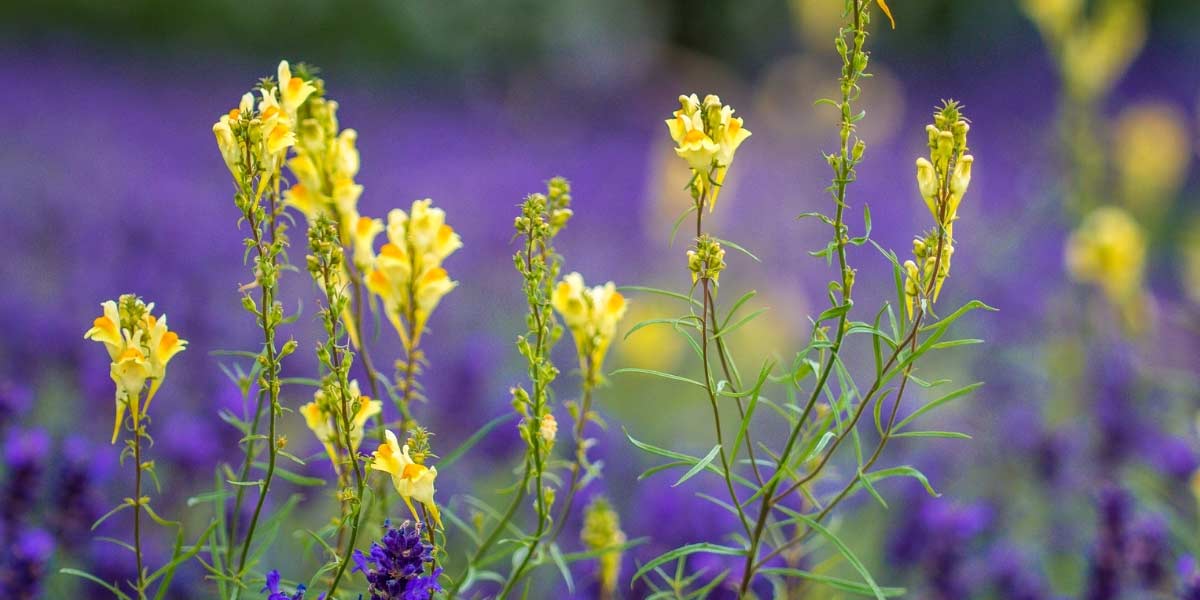
Linaria vulgaris
Multiplication
We recommend increasing toadflaxes by sowing, although it is also possible to propagate them by cuttings or by division.
Sowing
To sow toadflaxes, you can harvest seeds contained in capsules that appear after flowering. However, if dealing with a horticultural variety, colours may not remain true to original young plant… but this may give a pleasing range of shades.
Annual species (such as Linaria maroccana) can be sown directly in open ground in early spring; while perennials are more often sown in pots under cover around March.
For sowing in pots :
- Prepare a pot or seed tray with potting compost. Firm and level surface.
- Scatter seeds across surface.
- Cover with a light layer of sieved growing medium.
- Water with a fine spray.
- Place pot under cold frame in a bright spot.
- Ensure growing medium remains slightly moist until germination.
- Set out young plants in open ground around May, once temperatures are mild and frost risk has passed.
You can stagger sowings to extend flowering period.
For sowing in open ground :
- Choose a suitable site and prepare soil. Refine seedbed by breaking clods and removing coarse elements (stones, weeds…).
- Scatter seeds over surface, by broadcasting.
- Cover with a fine layer of growing medium.
- Water with a fine spray.
Association
With its small flowers gathered in airy clusters, linaria is precious for bringing lightness and delicacy to borders. It easily finds its place at the front of perennial borders, ahead of larger plants. It lightens heavier, more massive foliage (bergenias, heucheras, hostas…).
A variety such as Linaria ‘Canon J. Went’ will be ideal in a romantic garden. Its fine clusters of pale pinkish-white flowers will pair beautifully with roses, lavender, astrances, hardy geraniums, sages, nepetas, foxgloves… Plant it at the base of your bush roses, in companion with other delicate flowers, such as pinks, for example Dianthus deltoides. You can also install climbing plants, such as clematis, training them over an arch or pergola. For an equally delicate, romantic atmosphere, linarias can also be integrated into cottage gardens, for example alongside Oriental poppies.
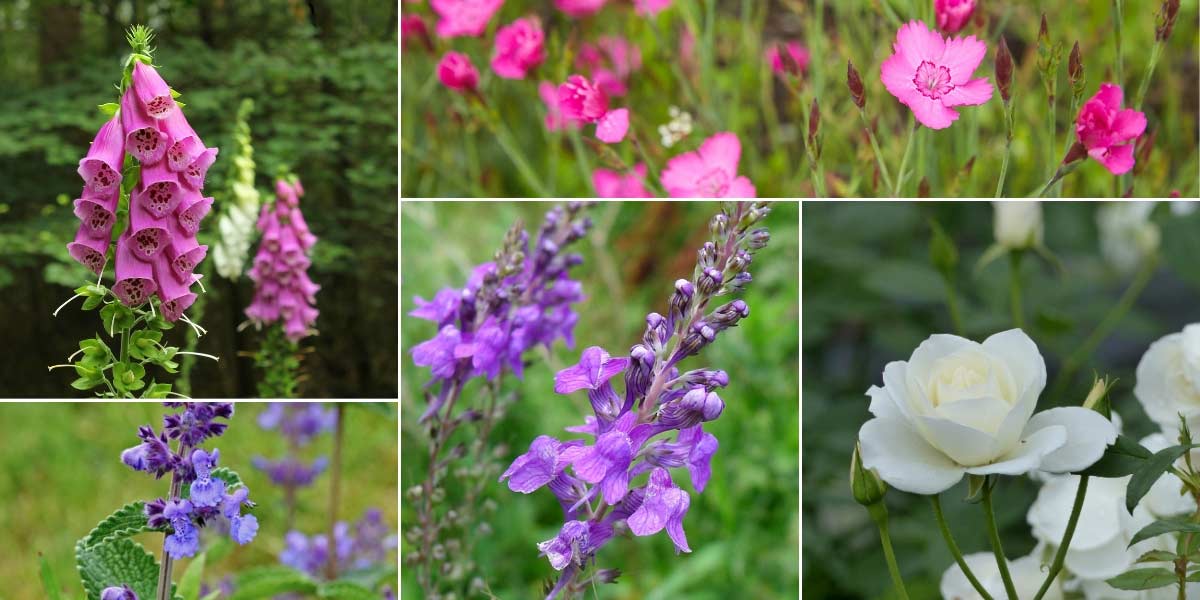
Linarias fit well into romantic gardens, especially alongside roses. Here, Digitalis purpurea (photo Matthijs van den Berg), Dianthus deltoides, Nepeta cataria (photo JLPC), Linaria purpurea (photo Gailhampshire), Rose ‘Iceberg’
Because they prefer well-drained, sunny soil, linarias are ideal for integrating into a rockery. Choose among the smaller species, such as Linaria alpina, which you can place with groundcover or cushion plants: Delosperma, Convolvulus sabatius, houseleeks, Geranium cinereum… You can also plant Linaria alpina on a low wall, between stones, for example with sedums, Campanula muralis, Cymbalaria muralis…
As it has a fairly natural habit, linaria allows you to create a wild, country-style garden. You can let it get on with life and self-seed. Plant it with other freely self-seeding plants (Nigella damascena, Lobularia maritima, alkanet…), for a garden in motion! Moreover, as it does not really need watering or fertiliser, linaria is ideal for ecological gardens, requiring minimal maintenance. Plant it with other undemanding plants with a free, airy habit: Verbena bonariensis, Gaura lindheimeri, achilleas, ornamental grasses…
Linarias also fit very well into dry gardens or gravel gardens. You can plant them with mulleins, Eryngium, Echinops, Stipa, Dipsacus, Oenothera, Centranthus… Choose plants that tolerate drought and accept poor, stony soil. You can also favour Mediterranean plants: lavender, euphorbias, Phlomis fruticosa, cistus…
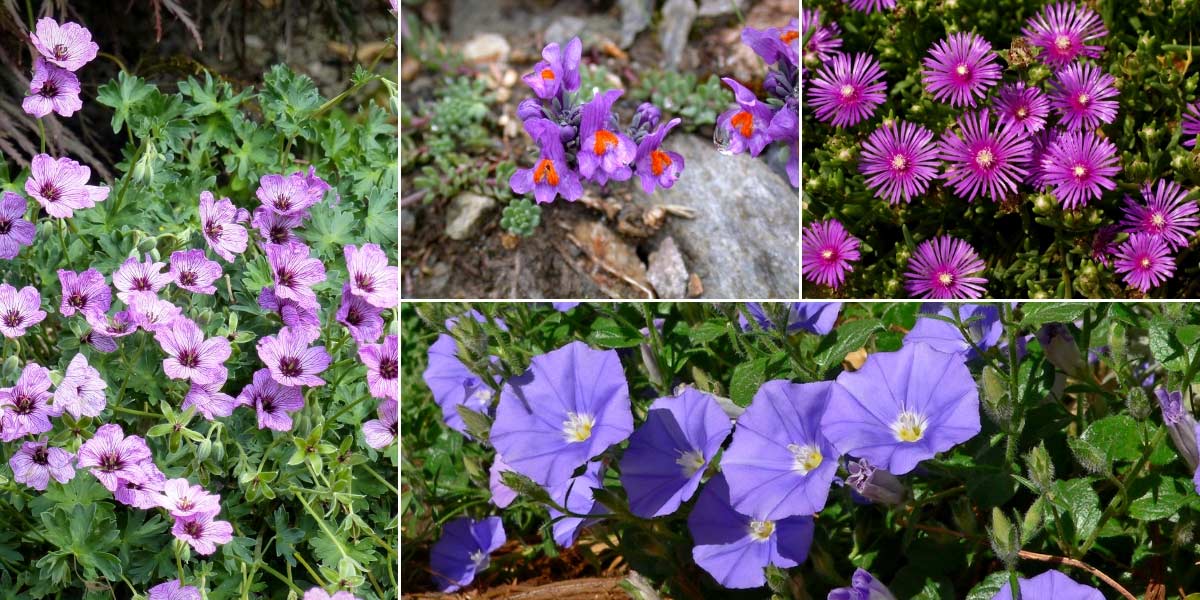
Small linaria varieties integrate easily into rockeries! Geranium cinereum ‘Lawrence Flatman’, Linaria alpina (photo Muriel Bendel), Delosperma cooperi (photo Alexander Klink), and Convolvulus mauritanicus (photo Stan Shebs)
Did you know?
- Medicinal plant
Common toadflax, Linaria vulgaris, has medicinal properties. It is notably diuretic, purgative, anti-inflammatory and effective against certain skin conditions. It is mainly used as an infusion.
Useful resources
- Discover our range of toadflax
- Discover our 5 ideas for pairing toadflax
- Our advice sheet – Sowing seeds: everything you need to know, our tips and tricks
Frequently asked questions
-
My toadflax self-seeds everywhere — how can I prevent this?
When they are happy in a spot, linarias tend to self-seed without becoming invasive. Simply cut flower stems once they have finished flowering. This prevents the plant from producing seeds.
-
Leaves of my toadflax are covered with white felt. Why?
They are probably affected by powdery mildew, a fungal disease. You can treat them with a sulphur-based solution or a horsetail decoction.
-
How to prolong flowering of your linariaA few quick, practical actions will extend linaria’s flowering period:- Deadhead regularly: Remove spent flowers by pinching or snipping just above the next set of leaves or a side shoot. This prevents seed set and encourages more blooms.- Cut back after first flush: Once the main flowering run finishes, cut plants back by about one-third (or to c.10–15 cm above soil). Many linaria varieties will produce a second flush of flowers.- Feed appropriately: Use a low‑nitrogen, higher phosphorus/potassium fertiliser (eg 5-10-10 or a “bloom booster”) every 4–6 weeks during the season. Too much nitrogen promotes foliage at the expense of flowering.- Water sensibly: Keep soil evenly moist while plants are actively flowering. Water deeply rather than frequently; avoid waterlogged soil by ensuring good drainage.- Light and soil: Most linaria prefer full sun or light afternoon shade and a well‑drained soil. Improving drainage or moving a container to a sunnier spot can increase flower longevity.- Pinch to encourage bushiness: Early in the season, pinch growing tips to promote branching and more flower spikes.- Succession sowing (for annual types): Sow small batches every 2–3 weeks to stagger flowering across the season.- Replace tired plants: Annual linaria (eg L. maroccana) will fade after prolonged flowering — replace or sow fresh plants for continuous colour. Perennial species (eg L. purpurea) may benefit from dividing or rejuvenating in spring.- Watch for pests and disease: Aphids or fungal problems can weaken plants and shorten flowering. Treat early and keep foliage airier by thinning crowded growth.- Encourage pollinators: Bees and hoverflies improve pollination dynamics and can help overall plant vigour.Note on species: Linaria maroccana (annual) and Linaria purpurea (short-lived perennial) behave differently — annuals respond well to succession sowing, perennials respond better to pruning and division.If you tell me which linaria species you have (or send a photo) and whether it’s in the ground or a pot, I can give more tailored advice.
We recommend removing spent flowers: this will encourage the plant to produce new ones. In this way, toadflaxes can produce a second, slightly later flowering.
- Subscribe!
- Contents
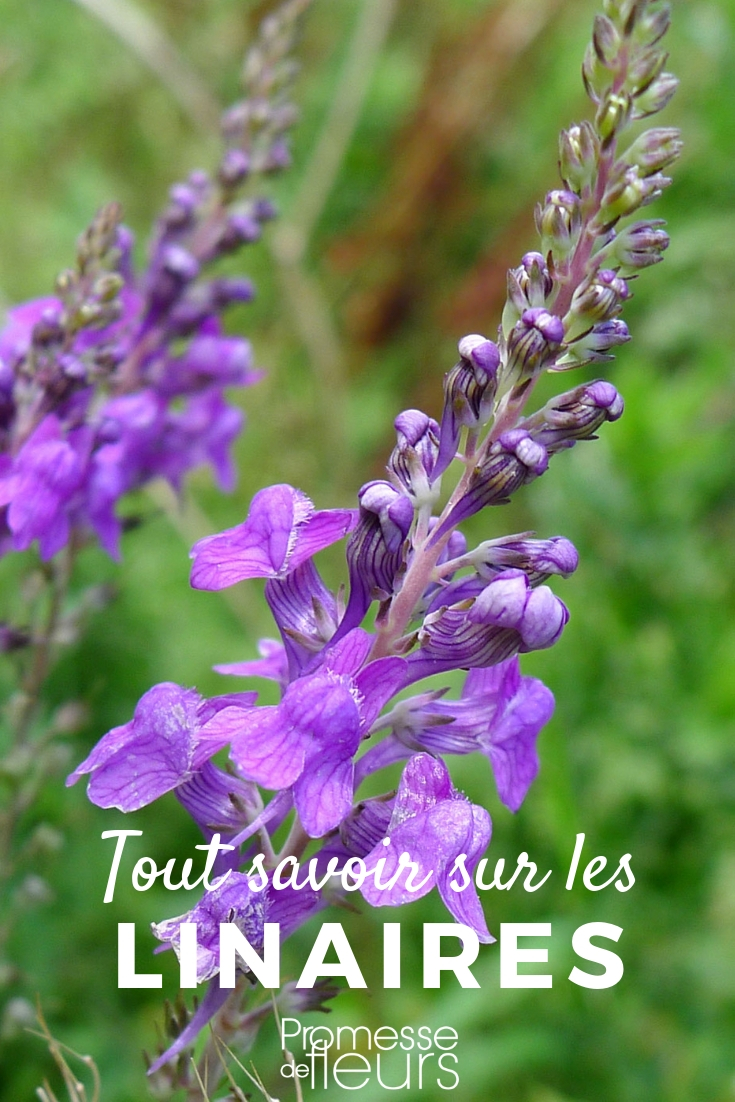































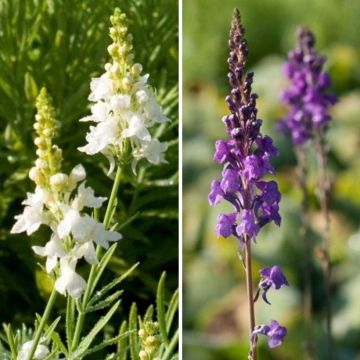
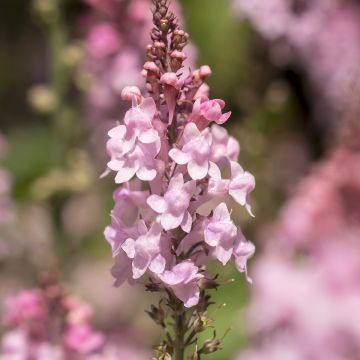



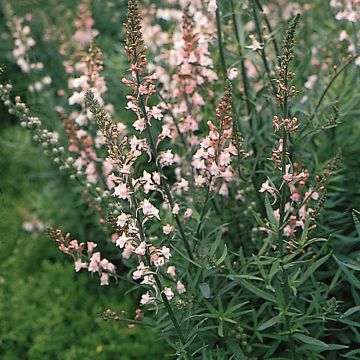
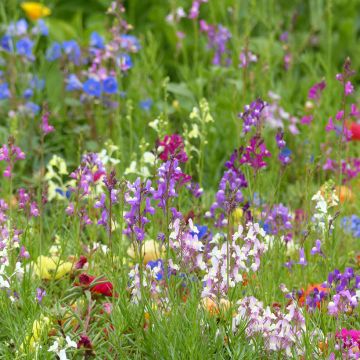
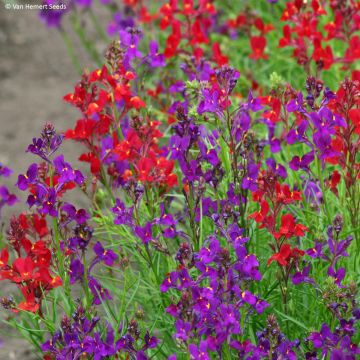
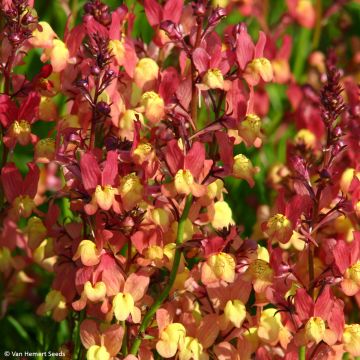
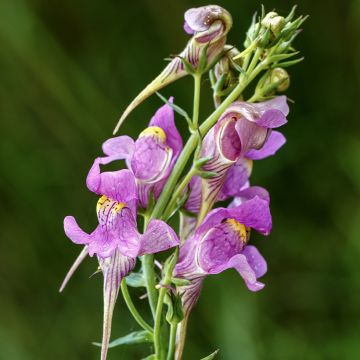
Comments